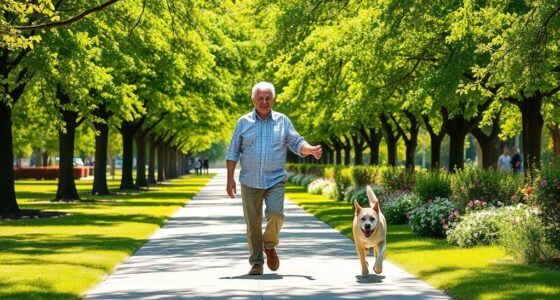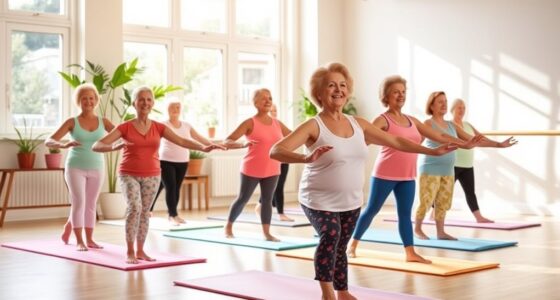To feel stronger every day, focus on effective strength training that respects your body’s limits. Use dumbbells for safety and practice proper form. Incorporate mobility and flexibility exercises like yoga to enhance balance and reduce the risk of falls. Prioritize nutritious meals, aiming for plenty of protein and healthy carbs to fuel your workouts. Don’t forget to recover with foam rolling and hydration. Stick with consistently structured routines, and there’s more to discover about optimizing your fitness journey.
Key Takeaways
- Focus on functional strength training using dumbbells to build muscle safely and effectively.
- Incorporate mobility and flexibility exercises like yoga to enhance joint health and prevent injuries.
- Prioritize recovery with practices like foam rolling and a balanced diet rich in proteins and healthy carbs.
- Engage in balance exercises, such as single-leg stands, to improve stability and reduce fall risk.
- Set realistic fitness goals and maintain consistent workout routines to support long-term strength and well-being.
Change Your Mindset

Changing your mindset is essential for enjoying workouts as you age. Instead of pushing yourself with the same intensity you’d in your 20s, focus on smart training that respects your body’s limits. By recognizing the natural decline in recuperation ability, you can set realistic fitness goals that help you stay healthy and build strength. Prioritize sleep, nutrition, and stress management to maintain an active lifestyle, as these elements are crucial for overall mental and physical well-being. Engaging in a balanced workout routine can also help you address emotional detachment that may arise from life changes. Incorporating a healthy breakfast can provide you with the necessary fuel to support your workout routine. Embrace a functional approach to your workouts, shifting your focus from aesthetics to improving your quality of life. Engaging in activities with family can further enhance your motivation and enjoyment. Additionally, consider the benefits of maintaining a positive mindset as it can significantly impact your overall experience and commitment to fitness. This mindset shift not only fosters better workouts but also guarantees you find joy in movement as you age. Remember, cultivating sustainable habits can enhance your overall well-being and contribute to a more fulfilling fitness journey.
Effective Strength Training Techniques

When it comes to strength training, using dumbbells can offer you greater safety and comfort, allowing for more controlled movements. Additionally, many successful startups have demonstrated the importance of agile methodologies to enhance responsiveness, which can be a valuable mindset for your fitness journey. Incorporating STEM toys into physical activity can also promote creativity and problem-solving skills, enhancing your overall workout experience. Recovery is just as important, as it helps your muscles rebuild and grow stronger after workouts; therefore, focusing on nutrition for recovery can significantly support your muscle health. Furthermore, engaging in regular maintenance practices for your workout routine can ensure you stay injury-free and improve your overall performance. Incorporating power training with lighter weights can boost your speed and combat muscle loss as you age, making it an essential part of your routine. Additionally, ensuring proper dilution guidelines for any essential oils used during post-workout recovery can enhance your overall relaxation and muscle relief.
Dumbbell Safety Considerations
As you commence strength training with dumbbells, it’s essential to prioritize safety to maximize your benefits and minimize the risk of injury.
Dumbbells are generally safer and more comfortable for older adults, allowing for a greater range of motion. To guarantee injury prevention, always practice proper form, especially with exercises like the Romanian deadlift or floor press, which accommodate common mobility limitations. Incorporating best home security systems for your home can also provide peace of mind, enabling you to focus on your workouts without worrying about safety concerns. Additionally, incorporating high-quality honey into your diet can provide essential nutrients that support overall health and wellness. Regular maintenance of your workout environment is crucial for safety, much like maintaining indoor air quality in your home, which can also improve your overall well-being. Remember that maintaining a consistent financial stability post-divorce can also help reduce stress, which may improve your workout performance.
Incorporating both total-body movements and bodybuilding isolation exercises in your routine can promote quicker recovery and targeted muscle engagement. This balanced approach helps develop all-encompassing strength while reducing fatigue and overexertion. Additionally, utilizing proper cleaning solutions for your equipment ensures they remain in optimal condition, promoting a safer workout environment.
Importance of Recovery
Recovery plays an essential role in your strength training routine, especially as you age. Proper recuperation allows for muscle repair and growth, which is vital since you may lose 3-8% of your muscle mass per decade after age 30. Incorporating skincare routines can enhance your recovery times, letting you engage in strength workouts without excessive fatigue. Post-workout practices like foam rolling and yoga can alleviate soreness and improve flexibility. Additionally, natural remedies like adequate hydration can further support your recovery process. It’s also important to consider Alzheimer bracelets for any family members with cognitive challenges, as they can provide peace of mind while you focus on your fitness. Maintaining a balanced diet is crucial for ensuring your body has the necessary nutrients to recover effectively.
Setting time limits on your training sessions helps prevent overexertion, ensuring you can sustain your routine. Don’t forget to prioritize protein intake—aim for 35 to 40 grams per meal—to support ideal recovery and muscle synthesis. Engaging in proper recovery techniques can significantly improve your overall performance and longevity in fitness.
Your body will thank you for it!
Power Training Benefits
Power training offers significant benefits for older men looking to maintain their strength and functionality. By focusing on explosive movements, you can effectively combat muscle loss and enhance your overall power.
Here are some key advantages of incorporating power training into your routine:
- Improved Muscle Strength: Target fast-twitch muscle fibers to maintain and increase strength.
- Enhanced Functional Performance: Exercises like medicine ball throws boost everyday movement efficiency.
- Better Coordination and Balance: Compound movements such as squats reduce fall risk.
- Supports Recovery: Aim for 35 to 40 grams of protein per meal to aid muscle synthesis post-training.
Additionally, incorporating primitive weapons into your training can enhance your adaptability and resourcefulness in various situations.
Regular 30-40 minute sessions will help you stay strong and independent as you age.
The Importance of Mobility and Flexibility

As you age, maintaining mobility and flexibility becomes essential for enhancing your daily functionality.
Regular mobility exercises not only help prevent injuries but also support joint health, keeping you active and independent.
Enhancing Daily Functionality
Mobility and flexibility are key components in maintaining your independence as you age. By incorporating mobility exercises into your routine, you can enhance your daily functionality and overall quality of life.
Here are some key benefits:
- Improved Joint Health: Regular mobility exercises reduce stiffness and pain.
- Enhanced Balance: Balance exercises, like tai chi or yoga, help prevent falls.
- Strength and Muscle Maintenance: Flexibility training supports muscle health and functionality.
- Health Benefits: Increased mobility promotes better circulation and mental well-being.
Engaging in these activities not only helps you stay active but also boosts your confidence, allowing you to enjoy daily tasks with ease.
Prioritize mobility and flexibility for a stronger, more independent life.
Injury Prevention Strategies
While aging brings many changes, maintaining your mobility and flexibility can greatly reduce your risk of injury. Incorporating mobility exercises, like neck stretches and hip rotations, is essential for enhancing flexibility and preventing stiffness.
Regular balance exercises, such as single-leg stands, lower your chances of falls, which are a common concern. Focus on subtle strength-building exercises, like the elevated hip bridge hold, to strengthen key muscle groups crucial for injury prevention.
Additionally, stretching routines targeting major muscle groups, especially your neck, shoulders, and back, alleviate tension and improve your overall range of motion.
Joint Health Benefits
Maintaining good joint health is essential for older men, especially as you age.
Prioritizing mobility and flexibility can greatly enhance your quality of life. Here are some key benefits:
- Improved Range of Motion: Regular mobility exercises boost joint function, allowing you to perform daily activities with ease.
- Reduced Pain: Consistent practice can alleviate joint pain, enhancing your comfort and independence.
- Enhanced Balance: Activities like tai chi or yoga promote stability, reducing the risk of falls.
- Better Circulation: Increased mobility supports joint health and keeps muscles functioning properly, contributing to overall fitness.
Nutrition for Optimal Performance

Nutrition plays an essential role in enhancing performance as you age, especially when it comes to supporting muscle recovery and maintaining energy levels. Aim for 35 to 40 grams of protein per meal to combat sarcopenia and encourage muscle health.
Following the ‘Perfect Plate’ guideline can help you balance your meals: fill ¼ of your plate with protein, another ¼ with healthy carbohydrates, and half with vegetables. Incorporate healthy carbohydrates like sweet potatoes, brown rice, and quinoa to fuel your workouts and sustain your energy.
Consider meal prepping once or twice a week to simplify healthy eating, ensuring you have nutritious options ready for superior performance. Don’t forget to stay hydrated and time your meals around workouts for the best results.
Balance Exercises for Fall Prevention
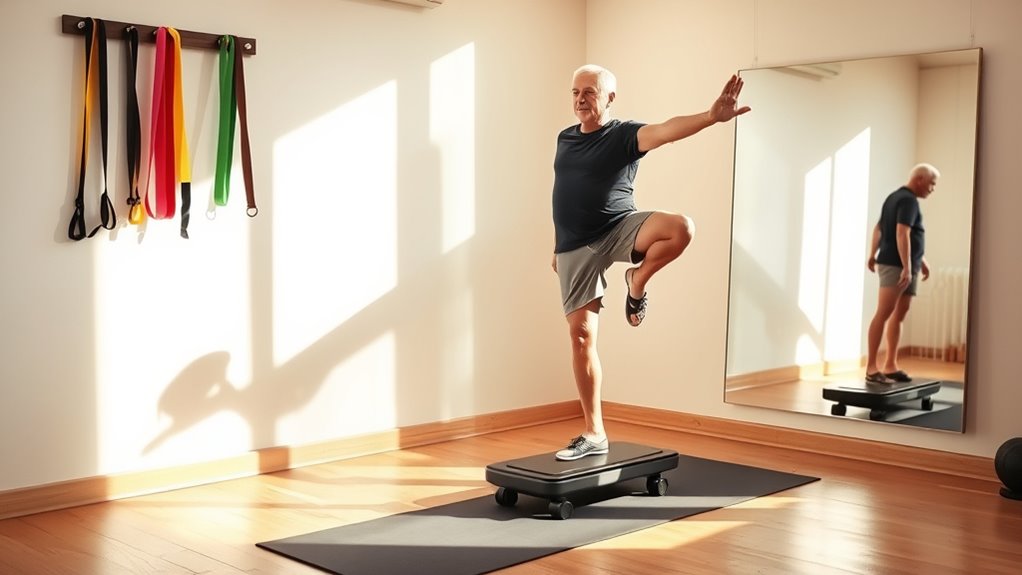
As you age, incorporating balance exercises into your routine becomes essential for preventing falls and maintaining independence.
These exercises enhance stability and improve proprioception, reducing your risk of falls. Here are four effective balance exercises to include:
- Standing on One Leg: Hold for 10-30 seconds, switching legs.
- Weight Shifts: Shift your weight from one foot to the other to improve stability.
- Tai Chi: This gentle martial art enhances balance on uneven surfaces.
- Yoga: Focus on poses that promote stability and coordination.
Aim to practice balance training three times a week.
Recovery Strategies for Better Results
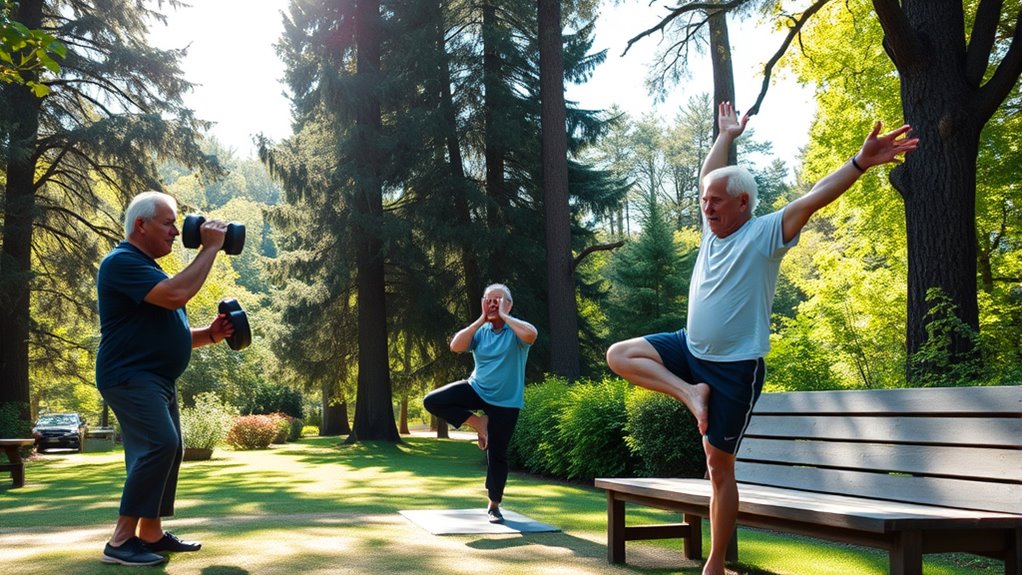
While balance exercises help you stay steady on your feet, recovery strategies are just as important for maximizing the benefits of your workouts.
Prioritizing recovery allows for muscle repair and growth, essential for combating sarcopenia and the natural decline in muscle mass. Incorporate foam rolling and yoga into your post-workout routine to reduce soreness and enhance flexibility.
Don’t forget your protein needs—aim for 35 to 40 grams of protein after each meal to optimize recovery. Keep your training sessions to 30-40 minutes to prevent overexertion.
Engaging in subtle exercises like the elevated hip bridge hold and Pallof press not only aids recovery but also strengthens key muscle groups, improving your overall alignment and reducing injury risk.
Creating a Consistent Workout Routine
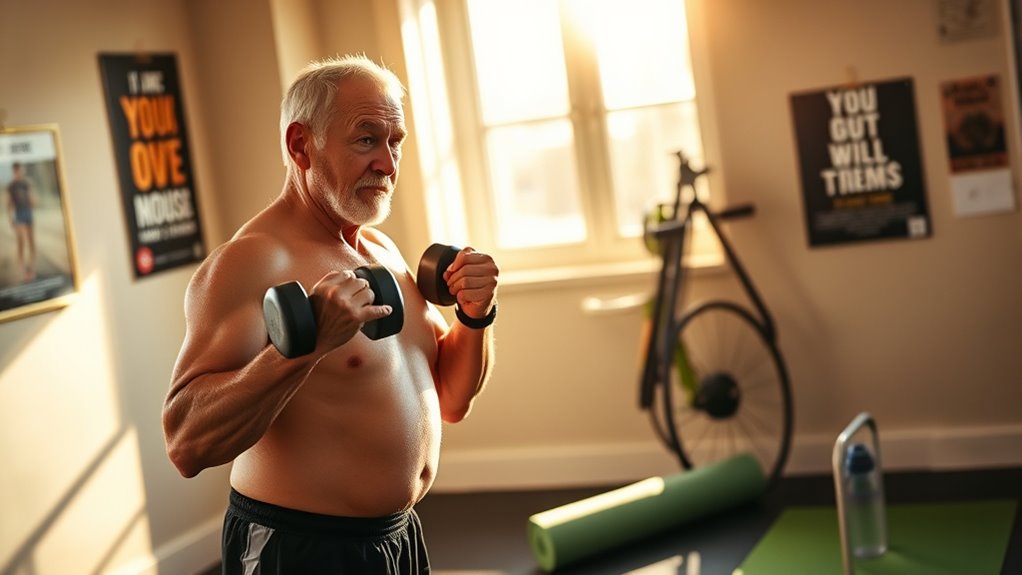
Creating a consistent workout routine is essential for maintaining your health and vigor as you age. To build a strong foundation, consider these key strategies:
- Aim for 150 minutes of aerobic activity weekly, breaking it into manageable 10- or 15-minute sessions.
- Incorporate strength training exercises at least two days a week to combat muscle loss and support bone health.
- Set specific, achievable goals to stay motivated and adjust your routine based on your fitness level and any limitations.
- Schedule workouts at the same time each day to create a habit, making it easier to prioritize physical activity.
Frequently Asked Questions
What Is the Best Strength Exercise for a 70 Year Old Man?
When considering the best strength exercise for a 70-year-old man, you might find bodyweight exercises like wall push-ups and chair squats beneficial.
These exercises build strength while reducing injury risk. Incorporating resistance training with dumbbells for bicep curls and shoulder presses can help enhance muscle mass.
Don’t forget about compound movements like seated leg presses, which engage multiple muscle groups, improving overall functional strength and daily activities.
Prioritize safety and listen to your body.
What Is the 6 12 25 Rule?
You might’ve heard that mixing heavy lifting with lighter reps can yield fantastic results.
The 6 12 25 Rule supports this idea, breaking down your workout into three parts: 6 reps of a heavy compound exercise for strength, 12 reps of a lighter isolation exercise for muscle engagement, and finishing with 25 bodyweight reps for endurance.
This method targets multiple muscle groups, enhancing both strength and functionality, making your workouts more effective and balanced.
Can a 70 Year Old Man Still Build Muscle?
Absolutely, you can still build muscle at 70!
Research shows that resistance training helps counteract muscle loss, known as sarcopenia. By lifting lighter weights with higher repetitions, you stimulate muscle growth safely.
It’s also important to consume enough protein after your workouts—aim for about 35 to 40 grams per meal.
Regular strength training not only enhances your physical abilities but also boosts your overall quality of life, keeping you strong and active.
How Often Should a 60 Year Old Man Strength Train?
You might think you can’t build strength at 60, but that’s far from the truth. Aim to strength train at least two days a week, focusing on major muscle groups.
Incorporate exercises like squats and push-ups, using moderate intensity. Don’t forget to allow 48 hours for recovery between sessions targeting the same muscles.
Conclusion
So, you thought getting older meant slowing down? Think again! By embracing strength training, mobility exercises, and proper nutrition, you’ll not only feel stronger but might just surprise yourself with how much energy you can have. Who knew that lifting weights and balancing on one leg could be the secret to defying age? With a consistent routine and smart recovery strategies, you’re not just aging—you’re thriving. So go on, show those younger guys how it’s done!




